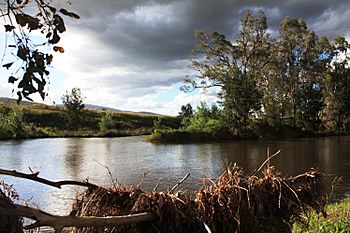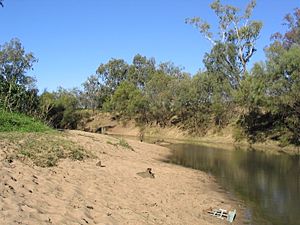Namoi River facts for kids
Quick facts for kids Namoi River |
|
|---|---|

|
|
| Country | Australia |
| State | New South Wales |
| Region | IBRA: New England Tablelands |
| District | Northern Tablelands, North West Slopes |
| Municipalities | Narrabri, Walgett, Gunnedah |
| Physical characteristics | |
| Main source | Moonbi Range, Great Dividing Range Near Niangala 708 m (2,323 ft) |
| 2nd source | Macdonald River |
| River mouth | Confluence with the Barwon River Near Walgett 130 m (430 ft) |
| Length | 708 km (440 mi) |
| Depth |
|
| Basin features | |
| River system | Barwon River, Murray–Darling basin |
| Basin size | 43,000 km2 (17,000 sq mi) |
| Reservoirs | Lake Keepit, Baraneal Lagoon |
The Namoi River is a big river in New South Wales, Australia. It's part of the larger Murray–Darling basin river system. This means its waters eventually flow into the Murray and Darling rivers.
The Namoi River starts on the western side of the Moonbi Range and Great Dividing Range, near a place called Niangala. It begins where the Macdonald River and Boundary Creek meet. From there, it flows mostly west.
Along its journey, the Namoi River is joined by 27 smaller rivers and streams, called tributaries. Some of these include the Peel, Manilla, and Mooki rivers. The Namoi River travels about 708 kilometers (440 miles) and drops 578 meters (1,896 feet) in height.
It passes by several towns like Gunnedah, Boggabri, Narrabri, Wee Waa, and Walgett. Finally, it meets the Barwon River near Walgett. Two important water storage areas, Lake Keepit and Baraneal Lagoon, help control the river's flow.
Where Does the Namoi River Flow?


The Namoi River starts high up in the Northern Tablelands. Its main sources, like the Macdonald, Peel, Cockburn, and Manilla rivers, begin on the western slopes of the Great Dividing Range. Other smaller streams that join the Namoi include Cobrabald River, Coxs Creek, Maules Creek, Mooki River, and Bundock Creek.
The river begins east of Niangala and flows northwest after the Cobrabald River joins it. It then goes through the villages of Woolbrook and Bendemeer. The river keeps flowing west and changes its name to the Namoi River at Boundary Creek. This is just before it enters Warrabah National Park.
The Namoi then flows past Manilla, where the Manilla River joins it. After passing into Keepit Dam, the Peel River adds its waters. The Namoi then flows by Carroll and is joined by the Mooki River near Gunnedah. From Gunnedah, it flows northwest past Boggabri, Narrabri, Wee Waa, and Burren Junction. Eventually, it connects with the Barwon River near the town of Walgett.
Keepit Dam, located near Gunnedah, is very important. It helps control floods and provides water for irrigation. The flat areas along the lower Namoi, especially around Wee Waa, are used to grow cotton. This cotton needs a lot of water, which comes from the dam.
A Look Back: History of the Namoi River
The Aboriginal people of the Kamilaroi nation have lived around the Namoi River for a very long time. They are the traditional owners of this land. The name Namoi or Nammoy is thought to come from an Aboriginal word for a type of acacia tree. Another meaning for ngamu in the Gamilaraay language is "breast." Some people also believe the name means "forked stick" or "meeting of the waters."
In 1827, a botanist and explorer named Allan Cunningham was the first European to explore the Namoi River. He named it "Mitchell" after a surgeon in Sydney.
The Namoi River Road Bridge was built in Manilla in 1886. This bridge is now on the Register of the National Estate, which means it's a very important historical site. It has eleven metal parts that criss-cross, making it one of the longest metal bridges built in Australia at that time.
Who Lives in the Namoi River? Animals and Fish
The Namoi River is home to many different kinds of fish and crustaceans (like crabs and yabbies). Some of the native fish you can find here include Murray cod, yellowbelly, silver perch, and catfish. You can also find yabbies, which are small freshwater lobsters. In some areas, yabbies are called "crawbob."
Murray cod in the Namoi River can grow very large, sometimes weighing 40 kilograms (88 pounds) or more! However, in the last 40 years, European carp and a lot of irrigation have caused challenges for the native fish. To help the native fish survive, volunteers have started programs to put more fish back into the river.
A special type of turtle, the Namoi River snapping turtle (also called Bell's turtle), lives only in the upper parts of the Namoi, Gwydir, and Macdonald rivers.
The platypus is another amazing animal found in this river. You can often spot them swimming around Warrabah National Park, which is east of Manilla.

